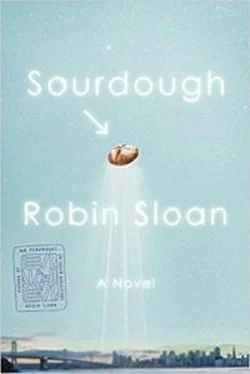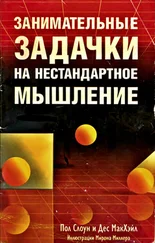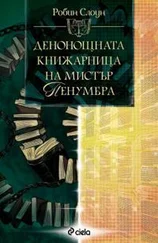Sometimes, when I was sitting at the long picnic table reading and rereading the papers, sipping endless cappuccinos provided by Naz, I paused to wonder: Who paid for all this?
The master of the market, the figure known universally as Mr. Marrow, was an enigma. Horace hypothesized that our patron was the scion of an old San Francisco family that had earned its fortune feeding the Barbary Coast. Naz was more paranoid, and said Mr. Marrow walked among us. “He could be Horace, for all we know.” I heard from others that Mr. Marrow was obviously Anthony Bourdain; definitely Ferran Adrià; indisputably Sergey Brin.
Every day, I carried a carton from the open pantry and placed it before the Vitruvian. One by one, it lifted the eggs, and one by one, it ruined them.
I imagined Mr. Marrow looking at a rapidly growing outlay for pasture-raised eggs and wondering, What the — ?
I had watched the Vitruvian make a hundred attempts without any apparent improvement. At the Task Acquisition Center, identical arms had ruined probably thousands of eggs. (What happened to those eggs? Did we, the Dextrous, eat them as breakfast scrambles? I hoped we did.) The problem wasn’t the training. There was something about this task that eluded ArmOS, even when it had mastered so many others. It could assemble a phone, but it couldn’t open an egg.
Could I criticize it, really? My own egg-cracking experience was extremely limited—a cookie-baking spree during my senior year of college; everything but the egg and a little butter was already in the box—and in that time I had certainly never attempted to do it one-handed, which was what was required of the Vitruvian. Even with the benefit of two hands, my egg-cracking had been fumbling, borderline disastrous—a gentle rain of eggshell into the cookie mix, shards removed carefully one by one.
If I was going to have any hope of teaching the Vitruvian, I would have to master this skill myself.
I opened the expedient video-sharing website on my laptop, searched for “how to crack an egg,” and was rewarded with thousands of results. I selected the first and watched a disembodied hand crack an egg against the rim of a clear glass bowl and pull its halves apart, two fingers forward, two fingers back. The gesture was almost obscenely elegant. I tried to copy what I saw on the screen, and was rewarded with a smear of yolk across my palm.
I felt a surge of kinship with the Vitruvian. We were starting at the same level.
But there was a difference between us: I learned fast.
Thwack , crack , pull —after only a few attempts, I could do it as neatly as my faceless tutor. Thwack , crack , pull . There’s a technical term for this: “one-shot learning.” You see something once; you can do it. Programmers who work on artificial intelligence and robot locomotion regard it with nearly mystical awe.
Having mastered the elegant, one-handed egg-crack in if not one, then maybe three shots, I set myself to the deeper task of understanding it. I pushed all my awareness into my hands—muscles, tendons, finger pads. Thwack , crack , pull . Thwack , crack … another smear. As quickly as I had learned it, I unlearned it. Thwack … The egg didn’t even crack. My fingers trembled.
I repeated this cycle every afternoon for a week. Every session contained, at its peak, a few perfect, satisfying cracks, with the broken shell levered apart by the subtlest workings of my fingers and palm. But the sessions all ended the same way, with me so lost in amped-up self-awareness—proprioception!—that I was dinging the eggs harmlessly off the bowl, or demolishing them entirely, just like the Vitruvian. Our performance converged. I had nothing to teach it.
After this happened, I would angrily dispose of the broken eggs, feeling stupid and wasteful, then stomp up and down the concourse in frustration.
And I would watch other people work.
When Naz used his espresso machine, it was musical: clack of portafilter, hiss of steam, gurgle of milk, clink of saucer. When Anita worked her cricket flour into dough, she stared into space, thinking with her hands. That’s what I wanted to achieve. Even Jaina Mitra: when she shuttled samples between her great microbial menagerie and the DNA sequencer, her fingers and feet moved of their own accord. She was elsewhere, gaze clouded, brain churning. She could have done it with her eyes closed.
That, of course, was it.
I ran back to my workstation, opened my laptop, and made sure I was synchronized with the latest changes to ArmOS. It was going to be so simple. It was going to be so huge.
To date, my contributions to the codebase had all been tiny refinements—painstaking embroideries in the tight tapestry of Proprioception. I had also written a related debugging panel for Interface, but I would never admit to that.
Now I created a module from whole cloth. It was concise, not even a hundred lines of code, built in perfect symmetry around a single action. One by one, in exactly the right order, I suspended the arm’s motor control loops. Then I loaded the action directly into the PKD 2891 Stepper Motors, which most people didn’t realize you could do; they all had their own MCUs, with just enough memory for what came next. Then, one by one, I brought the motor control loops back online.
I finished my new module, named it, tried to compile, was informed of several embarrassing syntax errors, corrected them, compiled again. I flashed the Vitruvian with the new code and said aloud, “Try again.”
It plucked up an egg, moved it lightly into position, paused, and thwack ed the egg against the rim of the bowl. Just after the thwack , my new module took over. The motor control loops went dark. The arm wasn’t running blind; it was more like … a blink. Not even a hundred milliseconds, during which my new module said: Just go for it.
In the ArmOS codebase, as part of the Control package, I had created something new—a tiny space without feedback or self-awareness—and I had named it Confidence.
The yolk flowed out with the albumen while the shell came apart cleanly in the Vitruvian’s six-fingered grip. The arm swiveled and dropped the shell neatly into the small bowl I had set up for that purpose—the bowl that had never before this moment actually been needed.
I had solved the egg problem, and I had done so in the simplest way possible: not by adding code, but by taking it away. During the blink, the Vitruvian was no longer caught in a wash of continuous feedback. It was no longer second-guessing its second guesses a thousand times every second.
I bundled my new module into a pull request and sent it upstream, straight into the master branch of ArmOS. I didn’t even write a commit message. The module’s name would suffice. I waited for the emails. My heart was pounding.
“Do that again,” I told the Vitruvian.
Thwack , crack , pull .
My laptop pinged. It was a message from Peter, composed entirely of exclamation marks.
Confidence!
ELEPHANTS’ ARMPITS
HORACE’S E-NEWSLETTER brought with it a schedule of classes—the expertise of the Marrow Fair shared freely. Aeroponics with Kenyatta on Monday; cheese tasting with Orli on Tuesday; bug husbandry with Anita on Thursday; and on Friday, Jaina Mitra would teach a workshop on DNA sequencing.
I recruited Horace and we went together.
A very small group gathered at noon in the center of Jaina Mitra’s lab. Naz from the coffee bar was there, as well as Clay from NewBagel, and Kenyatta, one of the pink-light farmers.
Jaina Mitra offered a plastic dish. “Who wants to spit?”
Читать дальше










